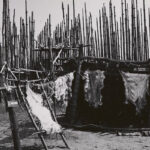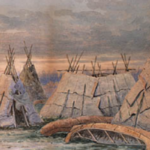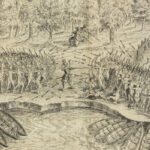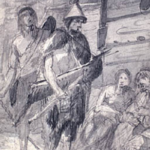The Mi’kmaq of Gesgapegiag: Keepers of the Eastern Shores
The Mi’kmaq of Gesgapegiag, a vibrant community nestled along the shores of the Gaspé Peninsula in Quebec, are part of the larger Mi’kmaq Nation, whose history spans thousands of years. Known for their adaptability, resourcefulness, and deep connection to the land and sea, the Mi’kmaq have weathered centuries of profound change, from the rhythms of pre-contact life to the disruptions and opportunities brought by European exploration. The story of the Mi’kmaq of Gesgapegiag is one of resilience and continuity, deeply tied to the Atlantic shores and its bountiful resources.
Pre-History: The Mi’kmaq and Their Land
The Mi’kmaq are among the most ancient Indigenous peoples of eastern North America, with archaeological evidence placing their ancestors in the Atlantic region for over 10,000 years. Their territory, known as Mi’kma’ki, encompassed what is now Nova Scotia, Prince Edward Island, New Brunswick, parts of Newfoundland, and the Gaspé Peninsula in Quebec. The land’s rivers, forests, and coasts provided the Mi’kmaq with the resources they needed to thrive.
As semi-nomadic people, the Mi’kmaq followed a seasonal cycle. Summers were spent along the coasts, where fishing, particularly for Atlantic salmon and cod, played a central role. Winters brought smaller family groups inland to hunt moose, caribou, and smaller game. Their intimate understanding of the environment allowed them to navigate the challenges of their rugged homeland with ingenuity and sustainability.
The Mi’kmaq worldview was deeply spiritual, rooted in respect for the natural world. They believed in Netukulimk, a principle of living in harmony with nature and taking only what was needed to sustain life. This principle guided their use of resources, ensuring that their environment remained abundant for future generations.
Governance and Social Structure
The Mi’kmaq of Gesgapegiag were part of a broader governance system that united the Mi’kmaq Nation. Their society was organized into districts, each with its own leader or Sagamore, and these districts were connected through the Grand Council or Santé Mawiómi. This council, composed of spiritual and political leaders, maintained peace among the districts, managed resources, and resolved disputes.
Leadership was grounded in consensus and respect for the wisdom of elders and community members. Decisions were made collectively, with chiefs and other leaders serving as mediators rather than authoritarian figures. This emphasis on shared governance fostered unity and resilience.
First Contact with Europeans
The Mi’kmaq were among the first Indigenous peoples in North America to encounter European explorers. By the early 16th century, Basque, Breton, and Norman fishermen frequented the waters off the Gaspé Peninsula, drawn by the region’s abundant cod fisheries. These early interactions were often limited to trade, with the Mi’kmaq exchanging furs for European goods such as metal tools, cloth, and beads.
The arrival of Jacques Cartier in 1534 marked a turning point in Mi’kmaq-European relations. Cartier’s exploration of the Gaspé Peninsula brought the Mi’kmaq into contact with French settlers and missionaries. The Mi’kmaq, skilled negotiators and traders, forged alliances with the French, who relied on their knowledge of the land and waterways.
The fur trade became a cornerstone of these interactions. The Mi’kmaq served as trappers and intermediaries, supplying furs to French traders in exchange for European goods. This trade brought both benefits and challenges. While European tools and goods enhanced Mi’kmaq life, the overharvesting of fur-bearing animals disrupted traditional economies, and exposure to European diseases such as smallpox caused devastating population losses.
Relationships with Missionaries and Settlers
The 17th century saw the arrival of Catholic missionaries, particularly the Jesuits, who sought to convert the Mi’kmaq to Christianity. The Jesuits established missions in Mi’kmaq territory, blending European religious practices with Mi’kmaq traditions. Many Mi’kmaq adopted aspects of Christianity, integrating it into their spiritual beliefs rather than abandoning their traditional practices.
The Mi’kmaq also developed strong alliances with French settlers. During conflicts such as King William’s War (1688–1697) and the Seven Years’ War (1756–1763), the Mi’kmaq fought alongside the French against British forces. These alliances were rooted in mutual benefit, as the French provided goods and protection while the Mi’kmaq offered their expertise in navigating and defending the land.
British Expansion and Encroachment
The British conquest of New France in 1763 brought new challenges to the Mi’kmaq. British policies often disregarded Mi’kmaq sovereignty, leading to encroachments on their lands and resources. The Proclamation of 1763, intended to protect Indigenous territories, was largely ignored by settlers eager to exploit the region’s resources.
Despite these pressures, the Mi’kmaq of Gesgapegiag adapted, maintaining their traditional practices while engaging with the new colonial economy. Many worked in fishing, logging, and other industries, blending these activities with seasonal hunting and gathering.
Cultural Resilience and Revitalization
Throughout their history, the Mi’kmaq of Gesgapegiag have demonstrated remarkable resilience in preserving their language, Mi’kmawi’simk, and cultural traditions. Oral traditions, drumming, and storytelling remain central to community life, ensuring that their heritage is passed down to future generations. Seasonal gatherings, including powwows and salmon fishing camps, provide opportunities to reconnect with traditional practices and celebrate their identity.
The Mi’kmaq of Gesgapegiag have also invested in language preservation through educational programs and immersion initiatives. These efforts ensure that Mi’kmawi’simk remains a living language, spoken by younger generations and central to their identity.
Environmental Stewardship and Advocacy
The Mi’kmaq of Gesgapegiag have long been stewards of the Gaspé Peninsula’s rich ecosystems. Traditional ecological knowledge guides their approach to resource management, ensuring that fishing, hunting, and forestry practices remain sustainable. However, modern challenges such as industrial development and climate change have heightened the need for advocacy.
The community has taken an active role in protecting their lands and waterways, partnering with governments and environmental organizations to address issues such as water quality, overfishing, and habitat loss. These efforts reflect their commitment to preserving Mi’kma’ki for future generations.
Gesgapegiag Today: A Thriving Community
Today, the Mi’kmaq of Gesgapegiag are a dynamic and forward-looking community of approximately 1,400 members. Investments in education, healthcare, and infrastructure reflect their commitment to creating opportunities for future generations. Cultural tourism, including visits to historical sites and participation in traditional activities, has become an important part of the local economy, showcasing the community’s rich heritage.
The Mi’kmaq of Gesgapegiag have also embraced modern governance while maintaining their traditional values. The Band Council, led by elected officials, works to balance economic development with cultural preservation, ensuring that the community remains strong and united.
Conclusion: A Legacy of Resilience and Continuity
The history of the Mi’kmaq of Gesgapegiag is a testament to their resilience, adaptability, and deep connection to the land. From their ancient presence along the shores of Mi’kma’ki to their central role in early European trade and their modern efforts in cultural revitalization and environmental advocacy, the Mi’kmaq have maintained their identity and place within Canada’s evolving landscape.
As an elder from Gesgapegiag once said, “Our strength lies in our connection to the land, our language, and our traditions. By honouring our past, we build a future that reflects who we are as Mi’kmaq.”
References
- Brightman, Robert. Grateful Prey: Rock Cree Human-Animal Relationships. University of California Press, 1993.
- Whitehead, Ruth Holmes. *The Old Man Told Us: Excerpts from Micmac History, 1500–



